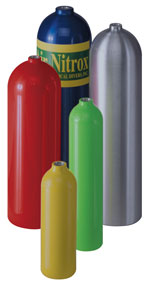|
How to choose a Scuba Tank
How to choose a scuba tank? Every dive shop, dive boat, and scuba diver uses these tanks. While we all have used the standard Aluminum 80 cubic foot tank, we have seen a great many different size and shapes in other tanks. Each of the “different” tanks have a unique advantage/disadvantage, use, and cost; How can you choose the right tank for you?
Let’s walk through the basic considerations to choose the perfect tank: • Budget. The reason the Aluminum 80 tank is everywhere is because it is cheap. But so are the Aluminum 50, 63, and 100 cubic foot tanks, so why is the 80 cubic foot the most popular? It is simply because it is the first Aluminum size (actually the second size), but the first 72 cubic foot Aluminum tanks were rounded bottoms and a bit taller. • Physical Size of the Scuba tank. It is generally the length of the tank and not the diameter that will bother most scuba divers. Carrying the tank without dragging it across the boat dock is a sign that either you cannot carry the weight or your arms are not long enough. If strength is not the problem than maybe the tank is too long. Or if you keep hitting you head on the tank valve and the bottom of the tank is bouncing off of your butt at the same time, than the tank is too long. The two main tank manufactures (Catalina and Luxfer) both make an Aluminum 80 tank that is 3 inches shorter than the standard tank. They do this by increasing the diameter of this new tank, but it is a little heaver. The Aluminum 63 cubic foot tank is 21.5 inches long. Some of the high pressure steel tanks are only 20 inches in length. • The Air Capacity of your tank. If your air consumption is markedly less than you dive buddy’s, why carry the extra air back to the boat? If I am diving with students, than a smaller 50 cubic foot is perfect. If I am diving with my wife than I use my 100 cubic foot tank, while she uses the 50 cubic foot tank. Choose the capacity that best matches your air consumption, dive objective and appropriate safety considerations. • Weight and Buoyancy considerations. The major disadvantage of Aluminum Scuba tanks is they tend to become positively buoyant at the end of each dive. The Aluminum 80 cubic foot tank can be up to 5 pounds of positive buoyancy at 500 psi. Both Luxfer and Catalina now make a newer neutral buoyancy Aluminum 80 tank to solve this problem. Of course you might want to consider a steel tank. These steel scuba tanks are approximately 20 inches in length and do not have the positive buoyancy problems that Aluminum tanks experience. The down side of the steel scuba tanks is that they operate at higher pressures and not all dive operations can fill them. The steel material tends to rust if any water or humidity enters the interior of the tank. Lastly the price of the steel tanks can be 2 or 3 times the prices of the Aluminum tank.
|
